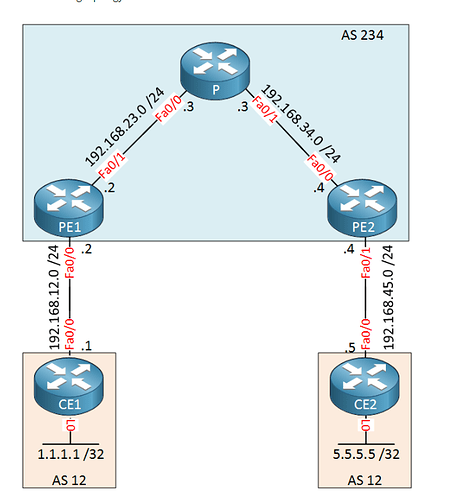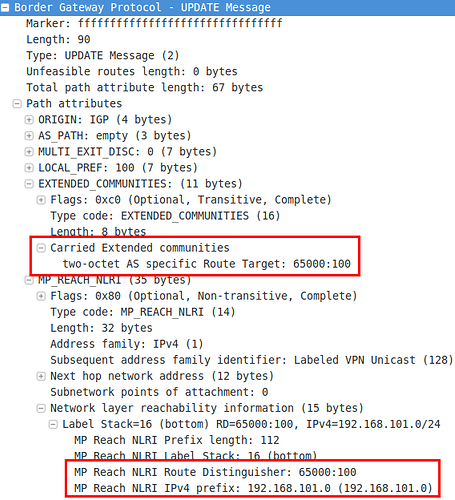Thanks for the reply Rene.
Yes I agree, I may have mixed up the CE/PE terminoligies, may be because CE routers are managed by us and the PE routers are ISP managed.
In my scenario, I have VRFs configured on CE1/CE2 routers, and I am not able to ping from VRF end to end. We are using eBGP bet CE1-PE1 and PE2-CE2.
I tried using OSPF bet CE1-PE1 and PE2-CE2, and I am able to ping VRFs end-to-end (VRF CE1 to VRF on CE2) i.e from CustA route to Cust-RTR route. But with eBGP, it does not work.
Yes, I did redistribute connected under the address-family ipv4 and I can see the route under ‘sh ip bgp vpnv4 all’ but not on the global routing bgp table ‘sh ip bgp’. So the PE1 router does not know abt the routes to CustA or CustB.
For instance see below:
On my CE2 router I am learning the route 192.168.253.0, which is VRF interface IP addr of CE1.
CE2#sh ip bgp vpnv4 all
BGP table version is 8, local router ID is 30.30.30.30
Status codes: s suppressed, d damped, h history, * valid, > best, i - internal,
r RIB-failure, S Stale, m multipath, b backup-path, f RT-Filter,
x best-external, a additional-path, c RIB-compressed,
Origin codes: i - IGP, e - EGP, ? - incomplete
RPKI validation codes: V valid, I invalid, N Not found
Network Next Hop Metric LocPrf Weight Path
Route Distinguisher: 1:1 (default for vrf C38)
*> 9.9.9.9/32 0.0.0.0 0 32768 ?
*> 192.168.253.0 192.168.0.10 0 0 64520 ?
Route Distinguisher: 2:2 (default for vrf C39)
*> 80.80.80.80/32 192.168.0.10 0 64520 64521 ?
*> 192.168.251.0 192.168.0.10 0 64520 64521 ?
CE2#
CE2#
CE2#ping vrf C38 192.168.253.245
Type escape sequence to abort.
Sending 5, 100-byte ICMP Echos to 192.168.253.245, timeout is 2 seconds:
.....
Success rate is 0 percent (0/5)
CE2#
CE2#traceroute vrf C38 192.168.253.245
Type escape sequence to abort.
Tracing the route to 192.168.253.245
VRF info: (vrf in name/id, vrf out name/id)
1 * * *
2 * * *
3 * *
CE2#
Also, on CE2 I have LO1 9.9.9.9 in vrf C38 and I learn the route on CE1 in vrf C38. But cant ping ir from CE1. See below:
CE1#sh ip bgp vpnv4 all
BGP table version is 7, local router ID is 20.20.20.20
Status codes: s suppressed, d damped, h history, * valid, > best, i - internal,
r RIB-failure, S Stale, m multipath, b backup-path, f RT-Filter,
x best-external, a additional-path, c RIB-compressed,
Origin codes: i - IGP, e - EGP, ? - incomplete
RPKI validation codes: V valid, I invalid, N Not found
Network Next Hop Metric LocPrf Weight Path
Route Distinguisher: 1:1 (default for vrf C38)
*> 9.9.9.9/32 192.168.0.18 0 0 64530 ?
*> 70.70.70.70/32 192.168.253.50 0 0 64522 ?
* 192.168.253.0 192.168.253.50 0 0 64522 ?
*> 0.0.0.0 0 32768 ?
Route Distinguisher: 2:2 (default for vrf C39)
*> 80.80.80.80/32 192.168.251.70 0 0 64521 ?
r> 192.168.251.0 192.168.251.70 0 0 64521 ?
CE1#
CE1#ping vrf C38 9.9.9.9
Type escape sequence to abort.
Sending 5, 100-byte ICMP Echos to 9.9.9.9, timeout is 2 seconds:
.....
Success rate is 0 percent (0/5)
CE1#tra
CE1#traceroute vrf C38 9.9.9.9
Type escape sequence to abort.
Tracing the route to 9.9.9.9
VRF info: (vrf in name/id, vrf out name/id)
1 * * *
2 * * *
3 * * *
4 * * *
5
CE1#
In this scenario, I am doing eBGP bet CE1-PE1, iBGP bet PE1-PE2 and eBGP bet PE2-CE2. Below is the bgp config on CE1 and CE2:
CE1#sh run | s bgp
router bgp 64520
bgp log-neighbor-changes
neighbor 192.168.0.9 remote-as 3549
neighbor 192.168.0.18 remote-as 64530
neighbor 192.168.0.18 ebgp-multihop 7
!
address-family ipv4
redistribute connected
neighbor 192.168.0.9 activate
no neighbor 192.168.0.18 activate
exit-address-family
!
address-family vpnv4
neighbor 192.168.0.18 activate
neighbor 192.168.0.18 send-community extended
exit-address-family
!
address-family ipv4 vrf C38
redistribute connected
neighbor 9.9.9.9 remote-as 64530
neighbor 9.9.9.9 ebgp-multihop 4
neighbor 9.9.9.9 activate
neighbor 192.168.253.50 remote-as 64522
neighbor 192.168.253.50 activate
exit-address-family
!
address-family ipv4 vrf C39
neighbor 192.168.251.70 remote-as 64521
neighbor 192.168.251.70 activate
exit-address-family
CE1#
CE2#sh run | s bgp
router bgp 64530
bgp log-neighbor-changes
neighbor 192.168.0.10 remote-as 64520
neighbor 192.168.0.10 ebgp-multihop 7
neighbor 192.168.0.17 remote-as 3549
!
address-family ipv4
redistribute connected
no neighbor 192.168.0.10 activate
neighbor 192.168.0.17 activate
exit-address-family
!
address-family vpnv4
neighbor 192.168.0.10 activate
neighbor 192.168.0.10 send-community extended
exit-address-family
!
address-family ipv4 vrf C38
redistribute connected
neighbor 192.168.253.245 remote-as 64520
neighbor 192.168.253.245 ebgp-multihop 4
neighbor 192.168.253.245 activate
exit-address-family
CE2#
When I use OSPF bet CE1-PE1, PE1-PE2, and PE2-CE2 and use mpls ip on all the non-vrf interfaces between, it just works fine. I am able to ping vrfs end-to-end
CE2#sh ip bgp vpnv4 all
BGP table version is 15, local router ID is 30.30.30.30
Status codes: s suppressed, d damped, h history, * valid, > best, i - internal,
r RIB-failure, S Stale, m multipath, b backup-path, f RT-Filter,
x best-external, a additional-path, c RIB-compressed,
Origin codes: i - IGP, e - EGP, ? - incomplete
RPKI validation codes: V valid, I invalid, N Not found
Network Next Hop Metric LocPrf Weight Path
Route Distinguisher: 1:1 (default for vrf C38)
*> 10.10.10.10/32 192.168.0.21 0 0 64531 i
*>i 70.70.70.70/32 20.20.20.20 0 100 0 64522 i
r> 192.168.0.20/30 192.168.0.21 0 0 64531 ?
*> 192.168.0.24/30 192.168.0.21 0 0 64531 ?
*>i 192.168.253.0 20.20.20.20 0 100 0 64522 i
Route Distinguisher: 2:2 (default for vrf C39)
*> 10.10.10.10/32 192.168.0.26 0 0 64531 i
*>i 80.80.80.80/32 20.20.20.20 0 100 0 64521 ?
*> 192.168.0.20/30 192.168.0.26 0 0 64531 ?
r> 192.168.0.24/30 192.168.0.26 0 0 64531 ?
*>i 192.168.251.0 20.20.20.20 0 100 0 64521 ?
CE2#
CE2#ping vrf C38 192.168.253.245 source GigabitEthernet1/0
Type escape sequence to abort.
Sending 5, 100-byte ICMP Echos to 192.168.253.245, timeout is 2 seconds:
Packet sent with a source address of 192.168.0.22
!!!!!
Success rate is 100 percent (5/5), round-trip min/avg/max = 80/91/96 ms
CE2#
GigabitEthernet1/0 int is in VRF C38. So it works with OSPF and not with BGP. Would like to know why, since even with BGP both CE1 and CE2 are learning vrf routes but cant ping.


